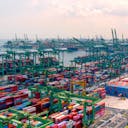This article is part of a series discussing the PoC with participants. In this one, we hear from Noam Rosenfeld, WaveBL’s CEO.
The bill of lading, which serves as document of title, contract of carriage and receipt for shipped goods, is still mostly paper-based. This holds back progress in container shipping which would benefit from the speed, cost reductions and improved sustainability an electronic bill of lading (eBL) could provide.DCSA works with its carrier members and other stakeholders to enable the transition from paper-based documentation to a fully interoperable electronic trade ecosystem. To this end, DCSA member carriers recently committed to a fully standardised eBL based on DCSA standards by 2030, heralding the start of a new era of scaled automation and paperless trade for container shipping.DCSA also completed a recent proof of concept (PoC) trial with platform providers, testing eBL interoperability through the full bill of lading lifecycle using data mirroring a live shipment.This article is part of a series discussing the PoC with participants. Here, we hear from Noam Rosenfeld, WaveBL’s CEO. We began by asking:Why do you think the eBL PoC interoperability collaboration is important?
Interoperability allows business partners to transfer eBLs between trade partners using different platforms. The eBL PoC showed that WaveBL seamlessly collaborates with other eBL platforms enabling interoperability.The proven successful interoperability is an important step toward enabling all business partners to choose an eBL platform and transfer possession of an eBL without worrying about which platform their business partners use.What results have you seen so far?
To reach the PoC goals, WaveBL provided the technological solution according to DCSA’s interoperability requirements. The PoC included all eBL platforms. During the PoC, we did more than just transfer the eBL to its next destination. We issued the eBL according to DCSA’s requirements and approved the surrender request to the carrier. Also, we approved and ensured the accuracy of all the transactions between the different service providers from issuance to surrender.The result we have seen so far is that cooperation between other platforms and carriers to achieve interoperability is attainable. Also, the platform collaboration created an open atmosphere that encouraged knowledge sharing.What are the lessons learned during this PoC?
The journey to complete the PoC was challenging and complex, both technologically and legally. The open communication between all platforms was an amazing achievement, proving that sharing knowledge brings amazing results, in that case, a successful PoC. The PoC proves without any doubt that the DCSA framework is achievable. WaveBL is proud to fully comply with DCSA’s interoperability standard and to support it technologically and legally every step of the way.What are the benefits to your customers once we achieve platform interoperability?
Interoperability could, among other things, help speed up eBL adoption. The challenge of onboarding users to the platform can be reduced in an interoperable environment. To complete an eBL transaction from issuance to surrender, all trade partners must agree to use eBLs and onboard the platform.Once interoperability is fully implemented, it will be easier for customers to commit to one platform.What does a fully interoperable eBL mean for international shipping and trade?
Interoperability could increase the adoption of eBLs. Many researchers have proven that digitalisation of bills of lading could change global trade and international shipping, e.g., it could boost Commonwealth trade by US$1.2tn. Other advantages include increased access to finance, cost savings, and risk and fraud reduction. This means that the trade industry as we know it today will change dramatically – in a good way.Has anything come out of this PoC experience that was perhaps unexpected or rewarding that you want to share with the industry?
The PoC boosted exposure and recognition of the importance of digitalisation and eBL adoption, which is also important for public discussion. The PoC also showed all trade partners along the supply chain that digitalisation is the future and that operability between eBL platforms is definitely achievable.To find out more about DCSA data and process standards for the bill of lading (B/L), visit the DCSA electronic bill of lading page.
Digitalise the container shipping industry
At DCSA, we envisage a digitally interconnected container shipping industry in which customers have a choice of seamless, easy-to-use services that provide the flexibility to meet their business and sustainability goals.









